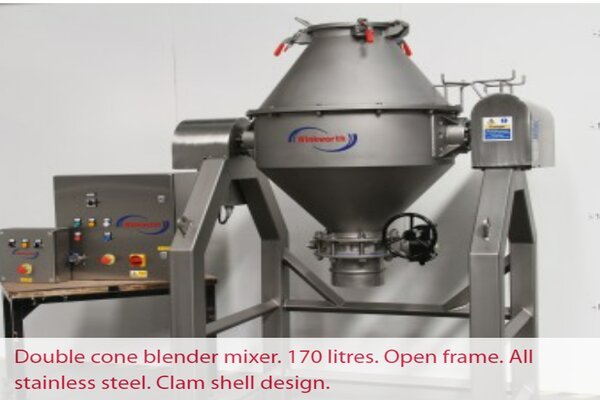Industrial Blenders
An Industrial Blender is a machine that is used in large-scale manufacturing. The blenders we use at home to produce shakes and smoothies may operate in the same way as industrial blenders, but they have different uses, capacities, and extra operations. Big tanks are capable of mixing large batches of items to be made, industrial blenders are used.
The continuing process, on the other hand, is more than just mixing. The purpose of Industrial blenders is to make it easier for the components to react. The first step is to combine all of the components. To get the desired result, the mixture is next subjected to particular regulated conditions such as mixing speed, duration, and temperature.
Industrial blenders are mostly used in scientific activities where chemicals and drugs must be mixed. Industrial blenders' precision and accuracy make them excellent for blending chemicals in precise proportions utilizing the blender's PLC programming. Blenders are often made of stainless steel due to the nature of their use, while those that do not need hygienic conditions are made of steel, cast iron, and aluminium.
Furthermore, these products are produced from well-balanced substances that are emulsified together by chemical bonding. Only an industrial mixing machine can produce this level of blending. Industrial blenders vary from ordinary blenders because of these complexities.
Uses of Industrial Blender
The capacity of an Industrial Blender to create mixes is its main advantage. People can calculate the correct proportions for a certain product and scale the components up to the blender's capacity. With these specialized devices, mixing may be done more quickly. Manufacturers can save money by employing an industrial blender to create a large number of homogenous ingredients.
In most contemporary manufacturing activities, this is a critical instrument. Industrial blenders are usually found in scientific contexts, such as chemical compounds and pharmaceutical production companies. For example, once pharmacologists have decided on the exact reaction to manufacture, say, a certain prescription pill, they program industrial blenders to make the breakdown and reaction easier on a bigger scale.
Another case in point is the food industry. Preservatives are added and stabilized using industrial blenders. Food items are blended with several sorts of chemical stabilizing agents to make them transportable and safe to eat.
Types of Industrial Blenders
Industrial blenders come in a variety of shapes and sizes, all of which are developed and constructed to fulfil the requirements of certain applications. Solids, liquids, and diverse mixes including Granules, Powders, Sticky pastes, Abrasive materials, and Stones are all blended in industrial blenders.
The key to successfully operating an industrial blender is to select one that is appropriate for the materials being mixed. Because there is such a large selection, a blender that perfectly fulfils the demands of a certain industrial application may be found.
Ribbon Industrial Blenders
Ribbon blenders get their name from the curvature of their blades, which resembles a ribbon. The blades revolve on a single axis. Ribbon blenders are excellent for eliminating lumps from liquids that have been sitting for a long time. Ribbon Industrial blenders are ideal for blending or mixing delicate components or materials that are sensitive to heat. Ribbon blenders are ideal for combining dry powders or pastes, and they're used to combine anything from animal feed to medications to baking ingredients.
These machines are also available in a variety of materials and finishes to meet your specific requirements. Ribbon Industrial Blenders are made up of two screw-like blades that are concentric on a single shaft but rotate in opposite directions: one helix rotates counter-clockwise while the other rotates clockwise. This operates similarly to paddle blenders, which force things together while blending them. This, on the other hand, allows for more complete shearing mixing and is better for moist substances.
Vibrational Industrial Blenders
The use of ultrasonic sound waves in vibrational industrial blenders is utilized to combine fine particles. An emulsifier's procedure is similar to that of an ultrasonic blend. A vibration blender employs ultrasonic waves instead of pressure to decrease and combine liquids. Vacuum bubbles or voids are created when ultrasonic vibrations travel through a liquid or slurry.
The bubbles expand as the waves continue, but they eventually burst when they can no longer absorb any more energy. Ultrasonic cavitation is the name given to this method, which has been effectively utilized for mixing and blending. Vibration blending enables precise control of every component of the blending process, including the amplitude and duration of the ultrasonic waves.
Vertical Industrial Blenders
Vertical industrial blenders are appropriate for materials that are sensitive to shear and when floor space is restricted. They feature a blending screw that rotates slowly, much more gently than a horizontal blender. The material is gradually moved upward by the mixing screw as it rounds the conical chamber. The material slides back down through the middle to the bottom once it reaches the top of the conical form.
The screw rotates in a counter-rotating helical ribbon that forms four cross flows, three of which are forced and one of which is formed by gravity. The material is moved along the chamber's perimeter by an upward-driven flow. Vertical blenders are appropriate for applications that occur in dangerous places because of their moderate pace.
A vertical Industrial blender's efficiency allows it to blend a wide variety of batch sizes, starting at 10% of the blender's capacity. Blended materials are easily expelled by a valve at the conical chamber's bottom.
Applications Of Industrial Blenders
The huge capacity of Industrial blenders is the main reason they are an important element of manufacturing output. Products can be developed and designed using upscaled proportions to generate big volumes of the final blend. Industrial blenders are a worry-free and effective blending procedure that ensures smooth output, as is vital in any sector.
Blenders may be found in every business that requires a combination of components to create a finished product. Blenders are the fundamental instrument for finishing the process, from blending materials to produce loaves of bread to mixing polymers to manufacture plastic items.
Pharmaceutical
Pharmaceutical manufacturing needs equipment with excellent accuracy, uniformity, cleanliness, and efficiency. The rules are in place to safeguard the safety and purity of medications provided to the general population. To fulfil the essential requirements, pharmaceutical sector blenders are specialized and complicated.
Industrial Blenders are used to create emulsions, reduce particle size, complete chemical processes, modify material flow, and dissolve components. The pharmaceutical industry's diverse demands necessitate the usage of a variety of mixing machines.
Food
When people hear the phrase blender, they immediately think of the blender that sits on their kitchen counter and is used to prepare meals. Blenders are used for the same reason in the food business, but on a greater scale and in larger numbers. Dry blending, emulsification, dissolution, dispersion, and mixing of very viscous materials are all done with blenders in the food sector.
The primary approach for changing raw resources into delightful and edible food is blending. An Industrial blender's consistency may generate the appropriate texture and look for a culinary product. Processors can use tiny industrial blenders for small-scale projects and bigger, more durable blenders for longer production runs because of the diversity of blenders available.
Cosmetics
One of the cosmetics industry's issues is blending components that aren't designed to be blended, which necessitates emulsification to break down the materials' molecular structure. Industrial Blenders provide higher control and accuracy, allowing producers to simply finish the blending process without damaging the integrity of the raw ingredients.
A blender must be flexible to the numerous variable consistencies, viscosities, and shearing needs of the many cosmetic products to meet the demands of the cosmetic business. Industrial blenders are particularly well adapted to this task.
Adhesives
The blending process is crucial to the successful processing and manufacture of adhesives. The kind, size, and manner of mixing impact the adhesive's efficiency and quality from homogenization through dissolution.
The various technological advancements in blender technology have substantially improved and refined the mixing of adhesive ingredients, resulting in greatly better goods and their application. Epoxies, latex sealants, joint compounds, polybutene emulsions, polyurethane, and rubber cement are just a few of the adhesives made with an industrial blender.
Our Principal
Kiron Food Processing Technologies with Winkworth has created cutting-edge mixing equipment that is designed to handle a processor's most difficult mixing, blending, and milling problems. We stand out from the competition because of our established mixing technology, scale-up assurances, and extensive application and ingredient knowledge.









